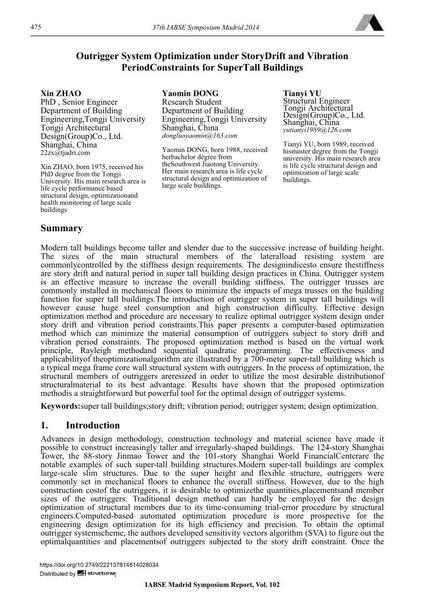Outrigger System Optimization under StoryDrift and Vibration PeriodConstraints for SuperTall Buildings

|
|
|||||||||||
Détails bibliographiques
| Auteur(s): |
Xin Zhao
Yaomin Dong Tianyi Yu |
||||
|---|---|---|---|---|---|
| Médium: | papier de conférence | ||||
| Langue(s): | anglais | ||||
| Conférence: | IABSE Symposium: Engineering for Progress, Nature and People, Madrid, Spain, 3-5 September 2014 | ||||
| Publié dans: | IABSE Symposium Madrid 2014 | ||||
|
|||||
| Page(s): | 475-482 | ||||
| Nombre total de pages (du PDF): | 8 | ||||
| Année: | 2014 | ||||
| DOI: | 10.2749/222137814814028034 | ||||
| Abstrait: |
Modern tall buildings become taller and slender due to the successive increase of building height. The sizes of the main structural members of the lateralload resisting system are commonlycontrolled by the stiffness design requirements. The designindicesto ensure thestiffness are story drift and natural period in super tall building design practices in China. Outrigger system is an effective measure to increase the overall building stiffness. The outrigger trusses are commonly installed in mechanical floors to minimize the impacts of mega trusses on the building function for super tall buildings.The introduction of outrigger system in super tall buildings will however cause huge steel consumption and high construction difficulty. Effective design optimization method and procedure are necessary to realize optimal outrigger system design under story drift and vibration period constraints.This paper presents a computer-based optimization method which can minimize the material consumption of outriggers subject to story drift and vibration period constraints. The proposed optimization method is based on the virtual work principle, Rayleigh methodand sequential quadratic programming. The effectiveness and applicabilityof theoptimizationalgorithm are illustrated by a 700-meter super-tall building which is a typical mega frame core wall structural system with outriggers. In the process of optimization, the structural members of outriggers areresized in order to utilize the most desirable distributionof structuralmaterial to ist best advantage. Results have shown that the proposed optimization methodis a straightforward but powerful tool for the optimal design of outrigger systems. |
||||
